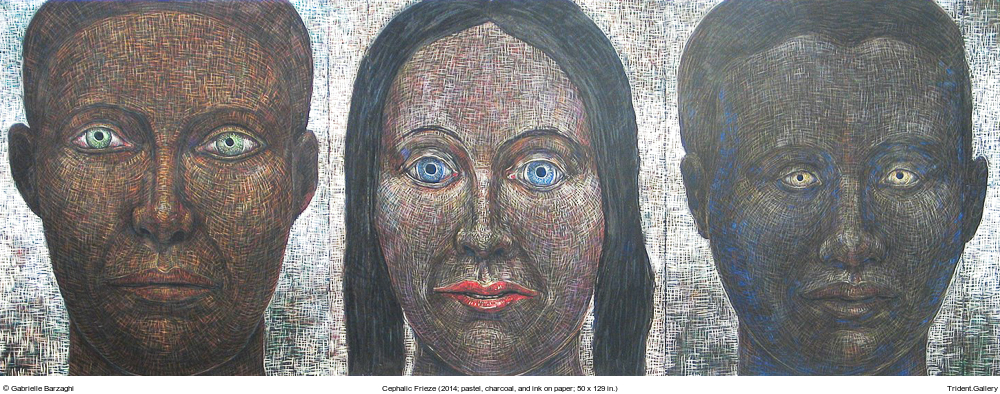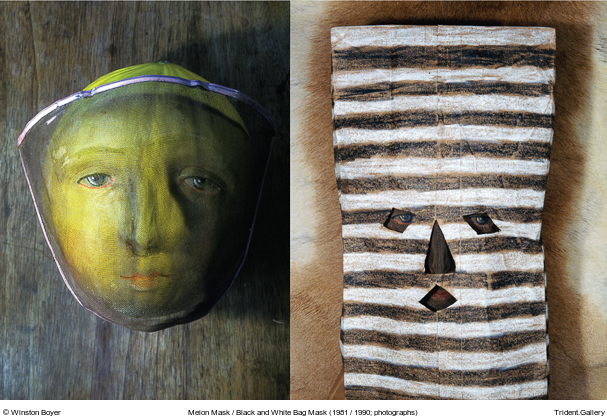
From 2009 to 2014, artist Gabrielle Barzaghi drew a series of large heads, about 50 x 40 inches and having tightly cropped compositions and neutral backgrounds. (Two were shown in Harbortown 2014.) Though large heads continue to appear in Barzaghi’s work, it seems fair to say that Cephalic Frieze was the last drawing in a particular series, and it is the only one showing more than one figure.
In this series of drawings, the surface of the human body, objectified like landscape, becomes a fascinating territory to explore. The large faces are rendered almost exclusively with hashed marks, a technique which leads to dramatic differences in the apparent texture and color of the faces within the range of normal viewing distances. This characteristic itself mimics our experience of landscape, which maintains meaning and aesthetic interest across a broad range of physical scale. Step away from Cephalic Frieze, and the intricate and charismatic gestures of the artist’s hashing resolves into uniform skin tones. Likewise, the vividly pure green and blue eyes of the two figures on the left, so compelling from afar, dissolve on closer inspection into a complex combination of marks and flashes of unexpected colors. Marvel as well, when you see the drawing, at the vividness of the dark blue streaks in the face of the figure on the right.
Barzaghi’s series of “portrait landscapes” posits topographical parallels for the life experiences of psyches and of bodies, invoking literary and religious narratives of life as a journey, and following traditions in the visual arts of rendering the journey of life etched in the surface of the body. The title of “frieze” and its corresponding composition sets Cephalic Frieze apart, within the artist’s series of heads, by invoking traditions of architecture and through them the ancient societies of Greece and Rome in which the architectural traditions are grounded. The temporal and cultural distances of centuries, and the aesthetic distance of architectural elements are positioned in parallel to the differences of perception with changing visual distance as ways in which the work of art develops meaning.
Cephalic Frieze was one of my core choices for The Political Body around which ideas for the exhibition coalesced. I had always been intrigued by the ambiguity of racial or ethnic identities of the two male figures. From this starting point and a general understanding of the artist’s interests and concerns, I discovered much more. The figures have monumental scale and in most cases impassive expressions that give us little to read in the way of character. In lieu of understanding character and emotion, we ask, as we do of monuments, Who and what do these persons represent? and The historical references of the drawing reinforce the racial and ethnic ambiguity (to my eyes) of the figures, and prompt me to resist and question my own inevitably narrow list of categories of race, ethnicity, and identity. I’m further prompted to ask, What were the terms of reference and thought which persons from the ancient societies of Rome, Greece, Egypt, and Persia used to describe races, ethnicities, and identity? And what do I learn by putting my labels and categories (African American, Asian, Mexican, Native American, European, etc.) into a wider context of history?
In summary, for me, Cephalic Frieze shows vividly how distance simplifies, which is a profound moral idea about personal identity. Greater distance, as with the perspective across centuries and societies, often confers more universal sympathies. And yet this gain comes with a cost and a moral peril. The distance which allows wider perspective is inseparable from the distance that allows—indeed requires—categorization, which eclipses and devalues sense experience and close attention to individual persons or objects. Direct, experiential knowledge is discarded in favor of a prior concept of the category, a concept influenced by experience but often strongly culturally determined and transmitted. Wider perspective can be gained only at the cost of losing track, in a process of abstraction, of individual complexity and variation, just as complex elements of the drawing resolve with spatial distance into simpler forms. The physical, sensory experience of this drawing reveals and contextualizes that slide of recognition and assimilation into pre-conceived types, which is morally required as a foundation of thought and understanding, and is at the same time so morally dangerous.


